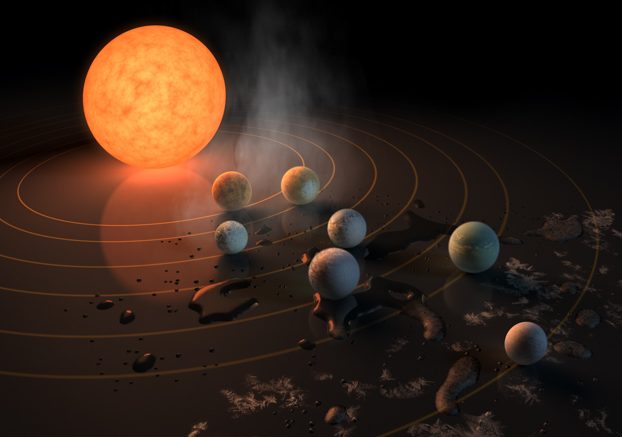It’s not aliens, but we might be close: NASA scientists have confirmed the discovery of a solar system filled with Earth-like planets.
In a video streamed on NASA TV on Feb. 22, NASA confirmed that Belgian astronomers have found seven exoplanets (meaning planets that orbit a star, beyond our solar system) orbiting a star named TRAPPIST-1, approximately 39 light years away. The discovery is particularly exciting because the planets appear to be around the same size as Earth, and six of the seven exoplanets are in a zone that keeps a temperature between 0 and 100C, leading researchers to believe there is a possibility life exists, or has existed, in this solar system. Along with this, the fact that three of the seven exoplanets appear to have the surface temperature to sustain liquid provides another clue towards the sustainability of alien life.
There is no other known star system that hosts so many planets with a size and rocky texture so similar to Earth.
“Further observations will not only help determine whether they are rich in water, but also possibly reveal whether any could have liquid water on their surfaces,” reads a NASA press release.
“The mass of the seventh and farthest exoplanet has not yet been estimated – scientists believe it could be an icy, “snowball-like” world, but further observations are needed.”
TRAPPIST-1 is younger than our sun and is expected to live another 10 trillion years, meaning if life has not yet formed, it may do so at some point. It was discovered by the Trappist (which stands for Transiting Planets and Planetesimals Small Telescope), which is stationed in the Atacama desert of Chile. TRAPPIST-1 was found using a process called transit photometry, which consists of observing planets as they pass a host star, and using the light they procure and the shadows they cast to figure out physical aspects of the planet, including shape and size. It is a red dwarf star, and all seven of its exoplanets orbit very close to it; even its farthest planet orbits closer to TRAPPIST-1 than Mercury, the closest planet in our solar system, orbits the Sun.
The next step for NASA and scientists worldwide is to continue observing TRAPPIST-1. The European Extremely Large Telescope (yes, that is its name) is still under construction, and slated to begin operation in 2024. It will be particularly important to the study of TRAPPIST-1, as it will be able to detect water and organic material in the protoplanetary disks around stars.
Researchers believe that TRAPPIST-1 is not alone. While TRAPPIST-1 is the first of its kind discovered, astronomers believe that there are as many as 40 billion habitable planets in our galaxy alone.


